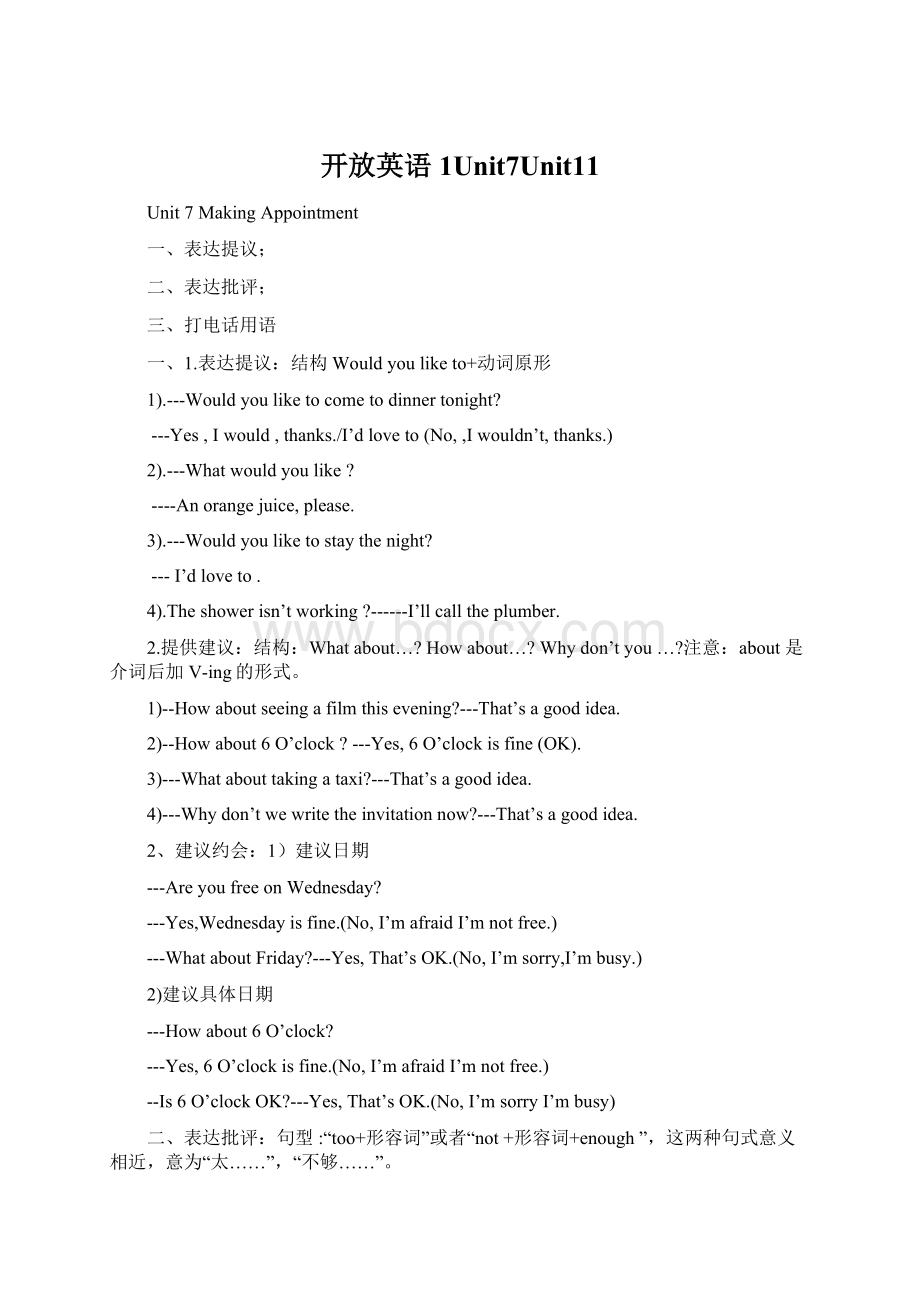 开放英语1Unit7Unit11.docx
开放英语1Unit7Unit11.docx
- 文档编号:8367383
- 上传时间:2023-01-30
- 格式:DOCX
- 页数:13
- 大小:26.09KB
开放英语1Unit7Unit11.docx
《开放英语1Unit7Unit11.docx》由会员分享,可在线阅读,更多相关《开放英语1Unit7Unit11.docx(13页珍藏版)》请在冰豆网上搜索。

开放英语1Unit7Unit11
Unit7MakingAppointment
一、表达提议;
二、表达批评;
三、打电话用语
一、1.表达提议:
结构Wouldyouliketo+动词原形
1).---Wouldyouliketocometodinnertonight?
---Yes,Iwould,thanks./I’dloveto(No,,Iwouldn’t,thanks.)
2).---Whatwouldyoulike?
----Anorangejuice,please.
3).---Wouldyouliketostaythenight?
---I’dloveto.
4).Theshowerisn’tworking?
------I’llcalltheplumber.
2.提供建议:
结构:
Whatabout…?
Howabout…?
Whydon’tyou…?
注意:
about是介词后加V-ing的形式。
1)--Howaboutseeingafilmthisevening?
---That’sagoodidea.
2)--Howabout6O’clock?
---Yes,6O’clockisfine(OK).
3)---Whatabouttakingataxi?
---That’sagoodidea.
4)---Whydon’twewritetheinvitationnow?
---That’sagoodidea.
2、建议约会:
1)建议日期
---AreyoufreeonWednesday?
---Yes,Wednesdayisfine.(No,I’mafraidI’mnotfree.)
---WhataboutFriday?
---Yes,That’sOK.(No,I’msorry,I’mbusy.)
2)建议具体日期
---Howabout6O’clock?
---Yes,6O’clockisfine.(No,I’mafraidI’mnotfree.)
--Is6O’clockOK?
---Yes,That’sOK.(No,I’msorryI’mbusy)
二、表达批评:
句型:
“too+形容词”或者“not+形容词+enough”,这两种句式意义相近,意为“太……”,“不够……”。
Idon’tliketheflat.It’stooneartheroad.我不喜欢这套公寓,离公路太近。
Thelivingroomisnotcomfortableenough.起居室不够舒服。
Idon’tliketheflat.It’stooneartheroad.我不喜欢这套公寓,离公路太近。
Thelivingroomisnotcomfortableenough.起居室不够舒服。
三、询问花多长时间。
句型“Ittakes+(时间)+todosth.”或者“
Sthtakes+(时间)表达“某事花多长时间”
---Howlongdoesittaketogettoyourtube?
---Ittakesabouthalfanhour.
Ittakesaboutfortyminutestogetfromtheairporttothecitycenterbytaxi.三、询问花多长时间。
句型“Ittakes+(时间)+todosth.”或者“
Sthtakes+(时间)表达“某事花多长时间”
---Howlongdoesittaketogettoyourtube?
---Ittakesabouthalfanhour.
从机场到市中心乘出租车大约需要40分钟。
四、打电话用语:
1、接电话时用:
Hello,Goodmorning,(goodafternoon)/goodmorning,CaffeRoma.
2、打电话时介绍自己用:
Thisis…/Thisis…speaking.
3、请人接电话时用:
1)Could/CanIspeakto…,please?
2)Is…in(there).please?
4、询问打电话者或者接电话者:
1)接电话者问打电话是谁,通常用Who’scalling?
/Who’sthat?
/WhomamIspeakingto?
2)接电话者恰好就是要找的人,可以说:
Isthat…?
/Isthatyou,..?
5、接听者找人接电话时:
Onemoment,please,I’llgether/him./sorry,he/sheisn’there./Holdon,please./sorry,I’mafraidhe/sheisout.
6、请对方转达口信Could/CanIleaveamessage,please?
1、can表示现在的能力,could表示过去的能力,例如:
HecanspeakalittleEnglishnow.
Shecouldplaythepianowhenshewasfive.
2、在表示请求许可时,没有时间区别,在语气上could更加委婉客气,例如:
CanIuseyourpen?
CouldIhavealookatyourbook?
3、在表示可能性方面,没有时间区别,can可能性比could大;1、can表示现在的能力,could表示过去的能力,例如:
HecanspeakalittleEnglishnow.
Shecouldplaythepianowhenshewasfive.
2、在表示请求许可时,没有时间区别,在语气上could更加委婉客气,例如:
CanIuseyourpen?
CouldIhavealookatyourbook?
3、在表示可能性方面,没有时间区别,can可能性比could大;表示逻辑上或理论上的可能性,而不是某种实际上将要发生或正在发生的可能性。
Canitbetrue?
这会是真的吗?
Anybodycanmakemistake.任何人都可能犯错误。
Theweatherherecouldbeverycoldinwinter.冬天这的天气有时很冷。
一般用于否定句和疑问句。
Hecan'tbeathome.他不可能在家。
注意和maynot的区别。
Hemaynotbeathome.他可能不在家。
也可以用于肯定句。
,
Anaccidentcanhappenifyoudothis.
如果你这样做,可能会发生事故
Unit8MovingIn
一、情态动词can表示允许;
二、一般现在时与现在进行时;
三、描述天气;
四、描述城市;
五、祈使句的结构。
一、情态动词can表示允许。
情态动词不能独立作谓语,一定要跟行为动词一起构成谓语。
情态动词:
can,could,may,might,must,need,will,would,shall,should.
1、情态动词can表示能力。
1)Icanswim.(我会游泳。
)2)Canyousing?
(你会唱歌吗?
)
2、情态动词can表示允许:
1)Youcanusethephoneinthelivingroom.你可以用起居室里电话。
2)Youcan’tsmokeinthebedroom.你不许在卧室里吸烟。
3)CanIusethecookerinthekitchenroom.我可以用厨房的餐具?
3、一般疑问句将can置于句首。
用于第一人称的疑问句可以表示询问他人是否允许。
否定有两种形式:
cannot或can’t
CanIusethephoneinthehall?
4、can用于肯定句表示允许,否定句表示不允许。
1)Youcansmokeinthekitchen.(改为否定句)à
Youcannot/can’tsmokeinthekitchen.
2)Sheshouldgotoseeadoctor.(改为否定句)àSheshouldn’tgotoseeadoctor.
3)Theymustdotheirhomeworktonight.(改为一般疑问句)à
Musttheydotheirhomeworktonight?
4)Youcanusethephoneinthelivingroom(改为一般疑问句)à
Canyouusethephoneinthelivingroom?
5)Hecansmokeinthegarden.(用what对划线部分提问)à
Whatcanhedointhegarden?
二、一般现在时与现在进行时。
1、一般现在时:
表示经常发生的事情(这些动作可能每天、每时或经常发生)。
1)Icookformyfamily.(我为家人做饭。
)
2)Shedoesn’tlikeborrowingthingsfromothers她不喜欢借别人东西。
2、现在进行时表示现阶段或说话的时刻正在发生的动作。
I’mtalkingnow.You’relisteningtome.I’mlookingforaflatonthegroundfloor.(我在寻找一套底楼的套房。
)
3、英语中动词就其词汇意义来讲分为表示动作的动词和表示状态的动词两类。
有些动词只用于一般现在时,而不能用于进行时。
这些动词表示相对静止的物质,心里及情感状态,被称为状态动词。
如:
tobe,tohave/tohavegot,tolike,tolove,tohate,tothink.HeisEnglish.Ihavetwobrothers.Ithinkit’scheap.但have作为行为动词,不表示拥有时,可以构成进行时。
I’mhavinglunch.Think做“想”、“思考”时也有进行时态。
三、描述天气:
询问天气状况常用What’s(whatis)theweatherlikein+(某地)。
回答用Itis(It’s)+形容词,或者Itis(It’s)+ing形式等。
注意:
it可以表示天气,时间,距离。
例如:
1)---What’stheweatherlikeinShanghai?
---It’srainy./It’sraining./It’ssunny/Thesunisshining.
2)---What’stheweatherliketoday?
---It’sfine/It’sshining./It’scloudy.
当谈论一个地方的气候(climate)时常用一般现在时而不用现在进行时。
ItoftenrainsinsummerinEngland.Itdoesn’tusuallysnowinwinterinIreland.
四、描述城市:
1、询问城市的状况用What’s(Whatis)+城镇名称+like?
What’sLondonlike?
(你觉得伦敦怎么样?
)
2、描述城市状况用tobe+形容词。
Londonisbusy,noisyandcrowded.
3、形容词及其反义词:
beautiful(漂亮的)---ugly(丑的,难看的),big---small,clean---dirty,busy---clam(安静的,宁静的)crowded---empty,modern---oldfashioned,safe---dangerous,quiet---noisy,well-organised(井井有条的)---chaotic(杂乱的)
五、祈使句:
可以表示请求和指令。
结构:
1、祈使句的肯定形式用动词原形。
Putitonthesmalltable.Sitdown,please.
2、祈使句的否定形式用Don’t+动词原形。
Don’tsand.
Don’tputthemonthedesk.Don’treadafterme.
六、描述物品所在的位置用It’snear/under/on/above/nextto/infrontof/behindthechair.
Unit9ThingsandPeople
一、问路和指路;
二、短语动词;
三、谈论人的外貌和性格特征。
一、问路和指路:
问路常用的句式为:
1、Whereis+场所?
2.Whereisthenearest+场所?
3、Isthere+a/an+场所?
1)---Isthereabanknearhere?
(这里附近有银行吗?
)
---Yes,thebankisonthecornerofthestation./Yes,thereis.Thereisabankonthecornerofthestation./I’msorry.I’mstrangerhere.
2)---Excuseme.Whereisthepostoffice,please?
(请问邮局在哪里?
)
---It’soutsidegreengrocer’s.(在水果店外面。
)/I’mnotfromaroundhere,I’mafraid.(我不是附近的人。
)
3)---Excuseme,whereisthenearestbank,please?
---It’snexttothenewsagent.(在报刊经售点隔壁。
)
4、就乘车问路和指路,常用get一词(getto…到达某地,geton上车,getoff下车)---Excuseme,howdoIgettothegym,please?
---Youtakethenumber866busfromthesupermarket.
二、短语动词:
短语动词是固定词组,由动词加介词或副词组成。
getup(起床),geton(上车),getoff(下车),getonwithsb(相处)getsbdown(使……情绪低落),getback(home/totheflat)(回到家/公寓),getin/out(进入/出来),getabout)走动,旅行。
Putup(aposter)(张贴海报),puton(weight/acoat)(增加体重/穿上外衣),comeacross(遇到某人、某物),findout(发现),ringup打电话),waitfor(等待),look(around)forsb/sth(四处寻找某人或某物),bring(sth)back带回某物,workout(锻炼身体),workoff(通过锻炼)减肥.
1)youcanpaintthewallsandputupposters.Youcandowhatyouwant.
2)Theygetonthebusatthestation.
3)Samgetsupat6O’clock.(起床)
4)Theygetoffthebusattheswimmingpool.(下车)
三、谈论人的外貌和性格特征:
1、Whatdoeshelooklike?
他长什么样儿?
2、What’shelike?
他(性格/长相)有什么特点?
1)---Whatdoeshelooklike?
(他长什么样儿?
)
----Heisverytallwithblueeyesandshortbeard.
2)---WhatdoesyourEnglishteacherlooklike?
你英语老师长什么样儿?
---Sheistallandhaslongwavyhair.
3)---What’syourbrotherlike?
---He’skind/shy/friendly/talkative.
4)---Whatdoesyourboyfriendlooklike?
---Heisquiettallwithfaircurlyhair.
下列这些词是描述人物的外貌的:
shortbrown/dark/fair/grey/curly/straight/wavyhair;blue/browneyes;shotbeard;short/tall;averageheight;slim;quitebig;onemeterseventy;
下列这些词是描述人物的性格的:
kind(好心的)sky(害羞的)funny(有趣的)friendly(有好的)quiet(文静的)intelligent(聪明的)stupid(愚蠢的)talkative(善谈的)confident(自信的)nice(和蔼的,和善的)outgoing(有好的,爽直的)serious(严肃的,认真的)
1.Heisveryniceandkind.He’squiteoutgoingandtalkative.
2.He’stallandhe’sgotshort,brownwavyhairwithblueeyesand
ashortbeard.
Unit10AnInvitation
一、复习表达提议;
二、提出请求;
三、谈论数量;
四、可数名词与不可数名词。
一、复习表达提议:
表达提议有三种方法。
1、1)Wouldyoulike+名词?
Wouldyoulikesomewater?
你要水吗?
---Whatwouldyoulike?
---Anorangejuice,please.
2)Wouldyoulike+to+动词?
----Wouldyouliketogowithus?
(和我一起去,好吗?
)
---I’dloveto.
3)Wouldyoulike+代词+to+动词?
WouldyoulikemetophoneTime?
你要我给Tim打电话吗?
2.I’ll(Iwill)+动词原形
---Theshowerisn’tworking.(淋浴器坏了。
)
---I’llcalltheplumber.
3.ShallI+动词原形
ShallIhelpyou?
(我能帮你吗?
)
ShallIgetsomeapples?
我要弄些苹果吗?
二、提出请求:
有三种方法。
1、Could+主语+动词原形?
Couldyoubeontimethisevening?
请你今晚准时到可以吗?
2、Can+主语+动词?
Canyoubringsomewine,please?
你带些酒,可以吗?
3、I+would+like+宾语+动词不定式
I’d(Iwould)likeyoutocallhim.我想叫你打电话给他。
I’dlikeyoutogetsomeprawns.我想叫你弄些大虾。
三、谈论数量:
英语中询问数量用1.Howmany+可数名词复数…?
2.Howmuch+不可数名词
1)Howmanyapplesdoyouwant?
你要多少苹果?
2)HowmanydaysdidyoustayinBeijing?
你在北京呆了几天?
3)HowmuchwatershallIbuy?
我要买多少水?
4)Howmuchmilkdoyouneed?
另外询问价格时也用Howmuch(money)…?
---Howmuchistherentoftheflat?
这套房子租金多少?
---Itis450poundsamonth.
Howmucharethey?
Howmuch(money)isit,please?
四、可数名词与不可数名词:
在英语中名词分为可数和不可数。
1、可数名词:
可数名词有单复数之分。
一个为单数,两个或者两个以上的为复数。
如:
apple---apples,anapple,threeapples,adesk,twodesks.
名词的复数就是在名词后加“-s”。
加“-s”的方法如下:
1)一般情况下直接加-s
如:
apple---apples,orange---oranges,cup---cups,prawn---prawns.
2)以辅音字母+y结尾,改y为i再+es。
如:
story---stories.
3)以s,xsh,ch,o结尾的+es,bus—buses,box---boxes,brush---brushes,
4)以f/fe结尾的,改f/fe为v再es.knife---knives
5)不规则的people---people,man---men,woman---women,child---children
2.不可数名词如:
water,milk,tea,rice,juice,food,coffee.
3、无论是可数与不可数都可以用some来修饰。
如:
somewater,someapples
4、不论是可数还是不可数名词,如果用一个表示量的词来修饰时,要用of
akiloofrice(一千克米),acartonofcream(一合奶油),acupoftea(一杯茶),aboxofpencils(一合铅笔),abagofapples(一袋苹果)
五、some和any的用法:
1、表示不确定的量,意思是“一些”,多用于肯定句,可修饰可数和不可数名词。
I’dlikesomewater.Wewantsomeoranges.Ineedsomemilk.
2.Any多用疑疑问句和否定句中,可修饰可数和不可数名词。
Haveyougotanylychees?
Idon’twantanytea.
但在有些表示提建议的疑问句中用some.Wouldyoulikeso
- 配套讲稿:
如PPT文件的首页显示word图标,表示该PPT已包含配套word讲稿。双击word图标可打开word文档。
- 特殊限制:
部分文档作品中含有的国旗、国徽等图片,仅作为作品整体效果示例展示,禁止商用。设计者仅对作品中独创性部分享有著作权。
- 关 键 词:
- 开放 英语 Unit7Unit11
 冰豆网所有资源均是用户自行上传分享,仅供网友学习交流,未经上传用户书面授权,请勿作他用。
冰豆网所有资源均是用户自行上传分享,仅供网友学习交流,未经上传用户书面授权,请勿作他用。


 如何打造酒店企业文化2刘田江doc.docx
如何打造酒店企业文化2刘田江doc.docx
